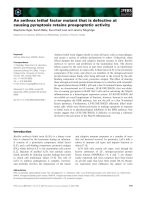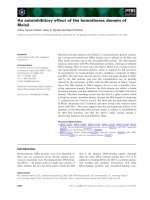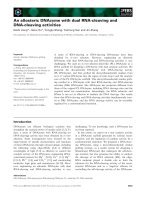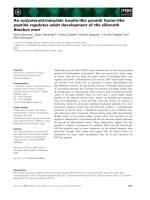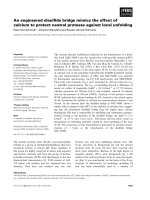Tài liệu Báo cáo khoa học: "An Open Source Toolkit for Phrase-based and Syntax-based Machine Translation" docx
Bạn đang xem bản rút gọn của tài liệu. Xem và tải ngay bản đầy đủ của tài liệu tại đây (261.46 KB, 6 trang )
Proceedings of the 50th Annual Meeting of the Association for Computational Linguistics, pages 19–24,
Jeju, Republic of Korea, 8-14 July 2012.
c
2012 Association for Computational Linguistics
NiuTrans: An Open Source Toolkit for
Phrase-based and Syntax-based Machine Translation
Tong Xiao
†‡
, Jingbo Zhu
†‡
, Hao Zhang
†
and Qiang Li
†
†
Natural Language Processing Lab, Northeastern University
‡
Key Laboratory of Medical Image Computing, Ministry of Education
{xiaotong,zhujingbo}@mail.neu.edu.cn
{zhanghao1216,liqiangneu}@gmail.com
Abstract
We present a new open source toolkit for
phrase-based and syntax-based machine
translation. The toolkit supports several
state-of-the-art models developed in
statistical machine translation, including
the phrase-based model, the hierachical
phrase-based model, and various syntax-
based models. The key innovation provided
by the toolkit is that the decoder can work
with various grammars and offers different
choices of decoding algrithms, such as
phrase-based decoding, decoding as
parsing/tree-parsing and forest-based
decoding. Moreover, several useful utilities
were distributed with the toolkit, including
a discriminative reordering model, a simple
and fast language model, and an
implementation of minimum error rate
training for weight tuning.
1 Introduction
We present NiuTrans, a new open source machine
translation toolkit, which was developed for
constructing high quality machine translation
systems. The NiuTrans toolkit supports most
statistical machine translation (SMT) paradigms
developed over the past decade, and allows for
training and decoding with several state-of-the-art
models, including: the phrase-based model (Koehn
et al., 2003), the hierarchical phrase-based model
(Chiang, 2007), and various syntax-based models
(Galley et al., 2004; Liu et al., 2006). In particular,
a unified framework was adopted to decode with
different models and ease the implementation of
decoding algorithms. Moreover, some useful
utilities were distributed with the toolkit, such as: a
discriminative reordering model, a simple and fast
language model, and an implementation of
minimum error rate training that allows for various
evaluation metrics for tuning the system. In
addition, the toolkit provides easy-to-use APIs for
the development of new features. The toolkit has
been used to build translation systems that have
placed well at recent MT evaluations, such as the
NTCIR-9 Chinese-to-English PatentMT task (Goto
et al., 2011).
We implemented the toolkit in C++ language,
with special consideration of extensibility and
efficiency. C++ enables us to develop efficient
translation engines which have high running speed
for both training and decoding stages. This
property is especially important when the programs
are used for large scale translation. While the
development of C++ program is slower than that of
the similar programs written in other popular
languages such as Java, the modern compliers
generally result in C++ programs being
consistently faster than the Java-based counterparts.
The toolkit is available under the GNU general
public license
1
. The website of NiuTrans is
2 Motivation
As in current approaches to statistical machine
translation, NiuTrans is based on a log-linear
1
19
model where a number of features are defined to
model the translation process. Actually NiuTrans is
not the first system of this kind. To date, several
open-source SMT systems (based on either phrase-
based models or syntax-based models) have been
developed, such as Moses (Koehn et al., 2007),
Joshua (Li et al., 2009), SAMT (Zollmann and
Venugopal, 2006), Phrasal (Cer et al., 2010), cdec
(Dyer et al., 2010), Jane (Vilar et al., 2010) and
SilkRoad
2
, and offer good references for the
development of the NiuTrans toolkit. While our
toolkit includes all necessary components as
provided within the above systems, we have
additional goals for this project, as follows:
z It fully supports most state-of-the-art SMT
models. Among these are: the phrase-based
model, the hierarchical phrase-based model,
and the syntax-based models that explicitly
use syntactic information on either (both)
source and (or) target language side(s).
z It offers a wide choice of decoding
algorithms. For example, the toolkit has
several useful decoding options, including:
standard phrase-based decoding, decoding
as parsing, decoding as tree-parsing, and
forest-based decoding.
z It is easy-to-use and fast. A new system can
be built using only a few commands. To
control the system, users only need to
modify a configuration file. In addition to
the special attention to usability, the
running speed of the system is also
improved in several ways. For example, we
used several pruning and multithreading
techniques to speed-up the system.
3 Toolkit
The toolkit serves as an end-to-end platform for
training and evaluating statistical machine
translation models. To build new translation
systems, all you need is a collection of word-
aligned sentences
3
, and a set of additional
sentences with one or more reference translations
for weight tuning and test. Once the data is
prepared, the MT system can be created using a
2
3
To obtain word-to-word alignments, several easy-to-use
toolkits are available, such as GIZA++ and Berkeley Aligner.
sequence of commands. Given a number of
sentence-pairs and the word alignments between
them, the toolkit first extracts a phrase table and
two reordering models for the phrase-based system,
or a Synchronous Context-free/Tree-substitution
Grammar (SCFG/STSG) for the hierarchical
phrase-based and syntax-based systems. Then, an
n-gram language model is built on the target-
language corpus. Finally, the resulting models are
incorporated into the decoder which can
automatically tune feature weights on the
development set using minimum error rate training
(Och, 2003) and translate new sentences with the
optimized weights.
In the following, we will give a brief review of
the above components and the main features
provided by the toolkit.
3.1 Phrase Extraction and Reordering Model
We use a standard way to implement the phrase
extraction module for the phrase-based model.
That is, we extract all phrase-pairs that are
consistent with word alignments. Five features are
associated with each phrase-pair. They are two
phrase translation probabilities, two lexical weights,
and a feature of phrase penalty. We follow the
method proposed in (Koehn et al., 2003) to
estimate the values of these features.
Unlike previous systems that adopt only one
reordering model, our toolkit supports two
different reordering models which are trained
independently but jointly used during decoding.
z The first of these is a discriminative
reordering model. This model is based on
the standard framework of maximum
entropy. Thus the reordering problem is
modeled as a classification problem, and
the reordering probability can be efficiently
computed using a (log-)linear combination
of features. In our implementation, we use
all boundary words as features which are
similar to those used in (Xiong et al., 2006).
z The second model is the MSD reordering
model
4
which has been successfully used in
the Moses system. Unlike Moses, our
toolkit supports both the word-based and
phrase-based methods for estimating the
4
Term MSD refers to the three orientations (reordering types),
including Monotone (M), Swap (S), and Discontinuous (D).
20
probabilities of the three orientations
(Galley and Manning, 2008).
3.2 Translation Rule Extraction
For the hierarchical phrase-based model, we follow
the general framework of SCFG where a grammar
rule has three parts – a source-side, a target-side
and alignments between source and target non-
terminals. To learn SCFG rules from word-aligned
sentences, we choose the algorithm proposed in
(Chiang, 2007) and estimate the associated feature
values as in the phrase-based system.
For the syntax-based models, all non-terminals
in translation rules are annotated with syntactic
labels. We use the GHKM algorithm to extract
(minimal) translation rules from bilingual
sentences with parse trees on source-language side
and/or target-language side
5
. Also, two or more
minimal rules can be composed together to obtain
larger rules and involve more contextual
information. For unaligned words, we attach them
to all nearby rules, instead of using the most likely
attachment as in (Galley et al., 2006).
3.3 N-gram Language Modeling
The toolkit includes a simple but effective n-gram
language model (LM). The LM builder is basically
a “sorted” trie structure (Pauls and Klein, 2011),
where a map is developed to implement an array of
key/value pairs, guaranteeing that the keys can be
accessed in sorted order. To reduce the size of
resulting language model, low-frequency n-grams
are filtered out by some thresholds. Moreover, an
n-gram cache is implemented to speed up n-gram
probability requests for decoding.
3.4 Weight Tuning
We implement the weight tuning component
according to the minimum error rate training
(MERT) method (Och, 2003). As MERT suffers
from local optimums, we added a small program
into the MERT system to let it jump out from the
coverage area. When MERT converges to a (local)
optimum, our program automatically conducts the
MERT run again from a random starting point near
the newly-obtained optimal point. This procedure
5
For tree-to-tree models, we use a natural extension of the
GHKM algorithm which defines admissible nodes on tree-
pairs and obtains tree-to-tree rules on all pairs of source and
target tree-fragments.
is repeated for several times until no better weights
(i.e., weights with a higher BLEU score) are found.
In this way, our program can introduce some
randomness into weight training. Hence users do
not need to repeat MERT for obtaining stable and
optimized weights using different starting points.
3.5 Decoding
Chart-parsing is employed to decode sentences in
development and test sets. Given a source sentence,
the decoder generates 1-best or k-best translations
in a bottom-up fashion using a CKY-style parsing
algorithm. The basic data structure used in the
decoder is a chart, where an array of cells is
organized in topological order. Each cell maintains
a list of hypotheses (or items). The decoding
process starts with the minimal cells, and proceeds
by repeatedly applying translation rules or
composing items in adjunct cells to obtain new
items. Once a new item is created, the associated
scores are computed (with an integrated n-gram
language model). Then, the item is added into the
list of the corresponding cell. This procedure stops
when we reach the final state (i.e., the cell
associates with the entire source span).
The decoder can work with all (hierarchical)
phrase-based and syntax-based models. In
particular, our toolkit provides the following
decoding modes.
z Phrase-based decoding. To fit the phrase-
based model into the CKY paring
framework, we restrict the phrase-based
decoding with the ITG constraint (Wu,
1996). In this way, each pair of items in
adjunct cells can be composed in either
monotone order or inverted order. Hence
the decoding can be trivially implemented
by a three-loop structure as in standard
CKY parsing. This algorithm is actually the
same as that used in parsing with
bracketing transduction grammars.
z Decoding as parsing (or string-based
decoding). This mode is designed for
decoding with SCFGs/STSGs which are
used in the hierarchical phrase-based and
syntax-based systems. In the general
framework of synchronous grammars and
tree transducers, decoding can be regarded
as a parsing problem. Therefore, the above
chart-based decoder is directly applicable to
21
the hierarchical phrase-based and syntax-
based models. For efficient integration of n-
gram language model into decoding, rules
containing more than two variables are
binarized into binary rules. In addition to
the rules learned from bilingual data, glue
rules are employed to glue the translations
of a sequence of chunks.
z Decoding as tree-parsing (or tree-based
decoding). If the parse tree of source
sentence is provided, decoding (for tree-to-
string and tree-to-tree models) can also be
cast as a tree-parsing problem (Eisner,
2003). In tree-parsing, translation rules are
first mapped onto the nodes of input parse
tree. This results in a translation tree/forest
(or a hypergraph) where each edge
represents a rule application. Then
decoding can proceed on the hypergraph as
usual. That is, we visit in bottom-up order
each node in the parse tree, and calculate
the model score for each edge rooting at the
node. The final output is the 1-best/k-best
translations maintained by the root node of
the parse tree. Since tree-parsing restricts
its search space to the derivations that
exactly match with the input parse tree, it in
general has a much higher decoding speed
than a normal parsing procedure. But it in
turn results in lower translation quality due
to more search errors.
z Forest-based decoding. Forest-based
decoding (Mi et al., 2008) is a natural
extension of tree-based decoding. In
principle, forest is a data structure that can
encode exponential number of trees
efficiently. This structure has been proved
to be helpful in reducing the effects caused
by parser errors. Since our internal
representation is already in a hypergraph
structure, it is easy to extend the decoder to
handle the input forest, with little
modification of the code.
4 Other Features
In addition to the basic components described
above, several additional features are introduced to
ease the use of the toolkit.
4.1 Multithreading
The decoder supports multithreading to make full
advantage of the modern computers where more
than one CPUs (or cores) are provided. In general,
the decoding speed can be improved when multiple
threads are involved. However, modern MT
decoders do not run faster when too many threads
are used (Cer et al., 2010).
4.2 Pruning
To make decoding computational feasible, beam
pruning is used to aggressively prune the search
space. In our implementation, we maintain a beam
for each cell. Once all the items of the cell are
proved, only the top-k best items according to
model score are kept and the rest are discarded.
Also, we re-implemented the cube pruning method
described in (Chiang, 2007) to further speed-up the
system.
In addition, we develop another method that
prunes the search space using punctuations. The
idea is to divide the input sentence into a sequence
of segments according to punctuations. Then, each
segment is translated individually. The MT outputs
are finally generated by composing the translations
of those segments.
4.3 APIs for Feature Engineering
To ease the implementation and test of new
features, the toolkit offers APIs for experimenting
with the features developed by users. For example,
users can develop new features that are associated
with each phrase-pair. The system can
automatically recognize them and incorporate them
into decoding. Also, more complex features can be
activated during decoding. When an item is created
during decoding, new features can be introduced
into an internal object which returns feature values
for computing the model score.
5 Experiments
5.1
Experimental Setup
We evaluated our systems on NIST Chinese-
English MT tasks. Our training corpus consists of
1.9M bilingual sentences. We used GIZA++ and
the “grow-diag-final-and” heuristics to generate
word alignment for the bilingual data. The parse
trees on both the Chinese and English sides were
22
BLEU4[%] Entry
Dev Test
Moses: phrase 36.51 34.93
Moses: hierarchical phrase 36.65 34.79
phrase 36.99 35.29
hierarchical phrase 37.41 35.35
parsing 36.48 34.71
tree-parsing 35.54 33.99
t2s
forest-based 36.14 34.25
parsing 35.99 34.01
tree-parsing 35.04 33.21
t2t
forest-based 35.56 33.45
NiuTrans
s2t parsing 37.63 35.65
Table 1: BLEU scores of various systems. t2s, t2t,
and s2t represent the tree-to-string, tree-to-tree, and
string-to-tree systems, respectively.
generated using the Berkeley Parser, which were
then binarized in a head-out fashion
6
. A 5-gram
language model was trained on the Xinhua portion
of the Gigaword corpus in addition to the English
part of the LDC bilingual training data. We used
the NIST 2003 MT evaluation set as our
development set (919 sentences) and the NIST
2005 MT evaluation set as our test set (1,082
sentences). The translation quality was evaluated
with the case-insensitive IBM-version BLEU4.
For the phrase-based system, phrases are of at
most 7 words on either source or target-side. For
the hierarchical phrase-based system, all SCFG
rules have at most two variables. For the syntax-
based systems, minimal rules were extracted from
the binarized trees on both (either) language-
side(s). Larger rules were then generated by
composing two or three minimal rules. By default,
all these systems used a beam of size 30 for
decoding.
5.2 Evaluation of Translations
Table 1 shows the BLEU scores of different MT
systems built using our toolkit. For comparison,
the result of the Moses system is also reported. We
see, first of all, that our phrase-based and
hierarchical phrase-based systems achieve
competitive performance, even outperforms the
Moses system over 0.3 BLEU points in some cases.
Also, the syntax-based systems obtain very
6
The parse trees follow the nested bracketing format, as
defined in the Penn Treebank. Also, the NiuTrans package
includes a tool for tree binarization.
BLEU4[%] Entry
Dev Test
Speed
(sent/sec)
Moses: phrase 36.69 34.99 0.11
+ cube pruning 36.51 34.93 0.47
NiuTrans: phrase 37.14 35.47 0.14
+ cube pruning 36.98 35.39 0.60
+ cube & punct pruning 36.99 35.29 3.71
+ all pruning & 8 threads 36.99 35.29 21.89
+ all pruning & 16 threads 36.99 35.29 22.36
Table 2: Effects of pruning and multithreading
techniques.
promising results. For example, the string-to-tree
system significantly outperforms the phrase-based
and hierarchical phrase-based counterparts. In
addition, Table 1 gives a test of different decoding
methods (for syntax-based systems). We see that
the parsing-based method achieves the best BLEU
score. On the other hand, as expected, it runs
slowest due to its large search space. For example,
it is 5-8 times slower than the tree-parsing-based
method in our experiments. The forest-based
decoding further improves the BLEU scores on top
of tree-parsing. In most cases, it obtains a +0.6
BLEU improvement but is 2-3 times slower than
the tree-parsing-based method.
5.3 System Speed-up
We also study the effectiveness of pruning and
multithreading techniques. Table 2 shows that all
the pruning methods implemented in the toolkit is
helpful in speeding up the (phrase-based) system,
while does not result in significant decrease in
BLEU score. On top of a straightforward baseline
(only beam pruning is used), cube pruning and
pruning with punctuations give a speed
improvement of 25 times together
7
. Moreover, the
decoding process can be further accelerated by
using multithreading technique. However, more
than 8 threads do not help in our experiments.
6 Conclusion and Future Work
We have presented a new open-source toolkit for
phrase-based and syntax-based machine translation.
It is implemented in C++ and runs fast. Moreover,
it supports several state-of-the-art models ranging
from phrase-based models to syntax-based models,
7
The translation speed is tested on Intel Core Due 2 E8500
processors running at 3.16 GHz.
23
and provides a wide choice of decoding methods.
The experimental results on NIST MT tasks show
that the MT systems built with our toolkit achieve
state-of-the-art translation performance.
The next version of NiuTrans will support
ARPA-format LMs, MIRA for weight tuning and a
beam-stack decoder which removes the ITG
constraint for phrase decoding. In addition, a
Hadoop-based MapReduce-parallelized version is
underway and will be released in near future.
Acknowledgments
This research was supported in part by the National
Science Foundation of China (61073140), the
Specialized Research Fund for the Doctoral
Program of Higher Education (20100042110031)
and the Fundamental Research Funds for the
Central Universities in China.
References
Daniel Cer, Michel Galley, Daniel Jurafsky and
Christopher D. Manning. 2010. Phrasal: A Toolkit
for Statistical Machine Translation with Facilities for
Extraction and Incorporation of Arbitrary Model
Features. In Proc. of HLT/NAACL 2010
demonstration Session, pages 9-12.
David Chiang. 2007. Hierarchical phrase-based
translation. Computational Linguistics, 33(2):201–
228.
Chris Dyer, Adam Lopez, Juri Ganitkevitch, Jonathan
Weese, Ferhan Ture, Phil Blunsom, Hendra Setiawan,
Vladimir Eidelman, Philip Resnik. 2010. cdec: A
Decoder, Alignment, and Learning Framework for
Finite-State and Context-Free Translation Models. In
Proc. of ACL 2010 System Demonstrations, pages 7-
12.
Jason Eisner. 2003. Learning non-isomorphic tree
mappings for machine translation. In Proc. of ACL
2003, pages 205-208.
Michel Galley, Mark Hopkins, Kevin Knight and Daniel
Marcu. 2004. What's in a translation rule? In Proc. of
HLT-NAACL 2004, pages 273-280.
Michel Galley, Jonathan Graehl, Kevin Knight, Daniel
Marcu, Steve DeNeefe, Wei Wang and Ignacio
Thayer. 2006. Scalable inferences and training of
context-rich syntax translation models. In Proc. of
COLING/ACL 2006, pages 961-968.
Michel Galley and Christopher D. Manning. 2008. A
Simple and Effective Hierarchical Phrase Reordering
Model. In Proc. of EMNLP2008, pages 848-856.
Isao Goto, Bin Lu, Ka Po Chow, Eiichiro Sumita and
Benjamin K. Tsou. 2011. Overview of the Patent
Machine Translation Task at the NTCIR-9 Workshop.
In Proc. of NTCIR-9 Workshop Meeting, pages 559-
578.
Philipp Koehn, Franz J. Och, and Daniel Marcu. 2003.
Statistical phrase-based translation. In Proc. of
HLT/NAACL 2003, pages 127-133.
Philipp Koehn, Hieu Hoang, Alexandra Birch, Chris
Callison-Burch, Marcello Federico, Nicola Bertoldi,
Brooke Cowan, Wade Shen, Christine Moran,
Richard Zens, Chris Dyer, Ondej Bojar, Alexandra
Constantin, and Evan Herbst. 2007. Moses: Open
Source Toolkit for Statistical Machine Translation. In
Proc. of ACL 2007, pages 177–180.
Zhifei Li, Chris Callison-Burch, Chris Dyer, Sanjeev
Khudanpur, Lane Schwartz, Wren Thornton,
Jonathan Weese, and Omar Zaidan. 2009. Joshua: An
Open Source Toolkit for Parsing-Based Machine
Translation. In Proc. of the Workshop on Statistical
Machine Translation, pages 135–139.
Yang Liu, Qun Liu and Shouxun Lin. 2006. Tree-to-
String Alignment Template for Statistical Machine
Translation. In Proc. of ACL 2006, pages 609-616.
Haitao Mi, Liang Huang and Qun Liu. 2008. Forest-
Based Translation. In Proc. of ACL 2008, pages 192-
199.
Franz Josef Och. 2003. Minimum error rate training in
statistical machine translation. In Proc. of ACL 2003,
pages 160-167.
Adam Pauls and Dan Klein. 2011. Faster and Smaller
N-Gram Language Models. In Proc. of ACL 2011,
pages 258–267.
David Vilar, Daniel Stein, Matthias Huck and Hermann
Ney. 2010. Jane: Open Source Hierarchical
Translation, Extended with Reordering and Lexicon
Models. In Proc. of the Joint 5th Workshop on
Statistical Machine Translation and MetricsMATR,
pages 262-270.
Dekai Wu. 1996. A polynomial-time algorithm for
statistical machine translation. In Proc. of ACL1996,
pages 152–158.
Deyi Xiong, Qun Liu and Shouxun Lin. 2006.
Maximum Entropy Based Phrase Reordering Model
for Statistical Machine Translation. In Proc. of ACL
2006, pages 521-528.
Andreas Zollmann and Ashish Venugopal. 2006. Syntax
Augmented Machine Translation via Chart Parsing.
In Proc. of HLT/NAACL 2006, pages 138-141.
24

